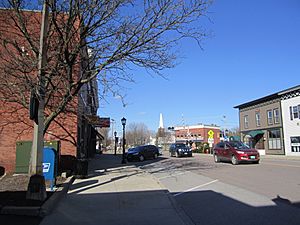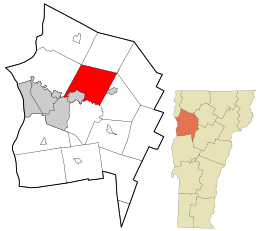Essex, Vermont facts for kids
Quick facts for kids
Essex, Vermont
|
|
|---|---|
 |
|
| Motto(s):
"Crossroads of Chittenden County"
|
|

Location in Chittenden County and the state of Vermont.
|
|
| Country | United States |
| State | Vermont |
| County | Chittenden |
| Incorporated | June 7, 1763 |
| Communities | Essex Junction Essex Center Butlers Corners Pages Corner |
| Area | |
| • Total | 39.3 sq mi (101.8 km2) |
| • Land | 38.8 sq mi (100.6 km2) |
| • Water | 0.5 sq mi (1.3 km2) |
| Elevation | 486 ft (148 m) |
| Population
(2020)
|
|
| • Total | 22,094 |
| • Density | 562.11/sq mi (217.03/km2) |
| Time zone | UTC−5 (Eastern (EST)) |
| • Summer (DST) | UTC−4 (EDT) |
| ZIP codes |
05451-05452
|
| Area code | 802 |
| FIPS code | 50-24175 |
| GNIS feature ID | 1462091 |
Essex is the second most populous incorporated area in Chittenden County and the entire state of Vermont, United States, with the first (in both cases) being Burlington at 42,545, according to the 2020 U.S. census. As of the 2020 Census, the population of Essex was 22,094. The village of Essex Junction is located within the town, and that village is home to the state of Vermont's busiest Amtrak station and largest private employer, GlobalFoundries. Vermont Route 289 crosses the town from east to west.
Contents
History
| Town vote to merge | Revote | |||
|---|---|---|---|---|
| District | 2006-11-07 | 2007-01-23 | ||
| Yes | No | Yes | No | |
| 6-1 (outside village) | 1,283 | 2,319 | 690 | 2,528 |
| 6-3 (outside village) | 365 | 822 | ||
| 6-2 (within village) | 2,728 | 1,026 | 2,009 | 362 |
| Townwide totals | 4,376 | 4,167 | 2,699 | 2,890 |
| Village vote to accept | No revote required, result was uncontested. |
|||
| 2,922 | 1,085 | |||
The town was incorporated on June 7, 1763, named after the Earl of Essex.
The village of Essex Junction was formed—within the town of Essex—on November 15, 1892. The village was formed to provide services (such as sidewalks, water, and sewers) to the villagers that the rest of the, mostly rural, town citizens did not want, and did not want to pay for.
As the town outside the village developed, they gradually added similar services for themselves, and by 1958, the first hints of merger showed up in a voter petition. Since then a series of votes (often contentious) had defeated or passed merger in each community, but never at the same time in both (which was required by the state legislature for them to sign off on the merger).
This temporarily changed on November 7, 2006, when merger passed in the town as a whole, and in the village. The town as a whole (including the village) got to vote once on the merger, and the village, separately, got to vote in a second ballot to accept the merger if it passed the townwide vote. This was confusing enough that the regional paper misreported the results as a defeat of the merger, based solely on the vote results outside the village. The next day the correct results were reported in both the town's paper, and as a correction in the regional paper.
On December 6, 2006, a petition to reconsider the merger was submitted to the town. The petition contained signatures totaling more than 5 percent of registered voters, which is the threshold required to force a re-vote. The revote was held on January 23, 2007, with a result that overturned the merger by 191 votes, rejecting the current merger proposal.
If the results had stood, a multi-year merger process would have resulted in a new "Town of Essex Junction" replacing the current governments of the town of Essex and the village of Essex Junction.
Geography
Essex is located in central Chittenden County, bordered on the south by the Winooski River. Neighboring municipalities are Colchester to the west, Milton at Essex' northwest corner, Westford to the north, Underhill at Essex' northeast corner, Jericho to the east, Williston to the south, and the city of South Burlington to the southwest. According to the United States Census Bureau, the town of Essex has a total area of 39.3 square miles (101.8 km2), of which 38.8 square miles (100.6 km2) is land and 0.50 square miles (1.3 km2), or 1.26%, is water.
The village of Essex Junction is located in the southwestern part of the town.
Demographics
| Historical population | |||
|---|---|---|---|
| Census | Pop. | %± | |
| 1790 | 354 | — | |
| 1800 | 729 | 105.9% | |
| 1810 | 957 | 31.3% | |
| 1820 | 1,089 | 13.8% | |
| 1830 | 1,664 | 52.8% | |
| 1840 | 1,824 | 9.6% | |
| 1850 | 2,052 | 12.5% | |
| 1860 | 1,906 | −7.1% | |
| 1870 | 2,022 | 6.1% | |
| 1880 | 2,104 | 4.1% | |
| 1890 | 2,013 | −4.3% | |
| 1900 | 2,203 | 9.4% | |
| 1910 | 2,714 | 23.2% | |
| 1920 | 2,449 | −9.8% | |
| 1930 | 2,876 | 17.4% | |
| 1940 | 3,059 | 6.4% | |
| 1950 | 3,931 | 28.5% | |
| 1960 | 7,090 | 80.4% | |
| 1970 | 10,951 | 54.5% | |
| 1980 | 14,392 | 31.4% | |
| 1990 | 16,498 | 14.6% | |
| 2000 | 18,626 | 12.9% | |
| 2010 | 19,587 | 5.2% | |
| 2020 | 22,094 | 12.8% | |
| U.S. Decennial Census | |||
2010 census
As of the census of 2010, there were 19,587 people and 7,322 households in the town. The racial makeup of the town was 91.6% non-Hispanic White, 1.5% Black or African American, 3.2% Asian, 0.3% Native American, 0.1% other races, and 1.8% from two or more races. Hispanic or Latino of any race made up 1.7% of the population. The population density was 534 people per square mile (184.4/km2). There were 7,170 housing units at an average density of 183.8 per square mile (71.0/km2). There were 7,013 households, out of which 38.5% had children under the age of 18 living with them, 59.7% were married couples living together, 8.8% had a female householder with no husband present, and 28.5% were non-families. 21.7% of all households were made up of individuals, and 5.5% had someone living alone who was 65 years of age or older. The average household size was 2.62 and the average family size was 3.09.
In the town, the age distribution of the population shows 27.9% under the age of 18, 6.8% from 18 to 24, 32.5% from 25 to 44, 24.6% from 45 to 64, and 8.2% who were 65 years of age or older. The median age was 36 years. For every 100 females, there were 97.4 males. For every 100 females age 18 and over, there were 94.8 males.
The median income for a household in the town was $58,441, and the median income for a family was $65,794. Males had a median income of $45,428 versus $27,426 for females. The per capita income for the town was $25,854. About 1.8% of families and 2.6% of the population were below the poverty line, including 2.4% of those under age 18 and 6.6% of those age 65 or over.
Arts and culture
Museums and other points of interest
The Harriet Farnsworth Powell Museum is located in Essex. The museum is housed in a former two-room schoolhouse, and includes a collection of costumes, school items, and local memorabilia.
Infrastructure
Transportation
Vermont's Circumferential Highway (Vermont Route 289 or "The Circ") courses through Essex, and the section within Essex's jurisdiction has been completed. However, further construction of the highway was halted in surrounding communities by court action from environmental protesters.
Bus service is provided by Green Mountain Transit.
Rail
Amtrak, the national rail passenger system, provides daily service via its station in Essex Junction, operating the Vermonter train between St. Albans, Vermont and Washington, D.C. In 2008, a study indicated that the cheapest method for one person to get to New York City from "Burlington" (Essex Junction), was by train at $48 one way. It was also the longest, taking an estimated 9 hours and 25 minutes.
Notable people
- Bert Abbey (1869–1962), pitcher with the Washington Senators, Chicago Colts, and Brooklyn Grooms/Bridegrooms
- William B. Castle, mayor of Cleveland, Ohio
- Linda K. Myers, member of the Vermont House of Representatives
See also
 In Spanish: Essex (Vermont) para niños
In Spanish: Essex (Vermont) para niños


